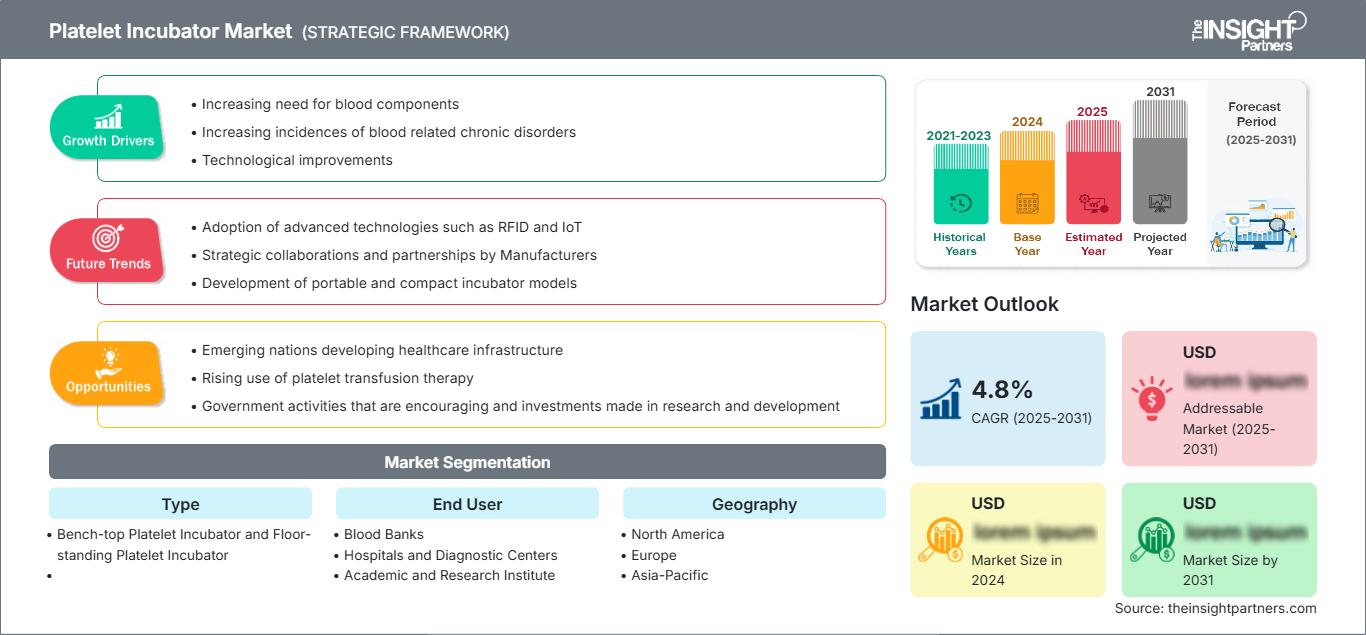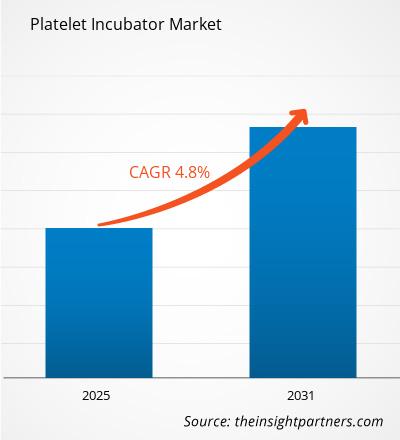Se espera que el tamaño del mercado de incubadoras de plaquetas alcance los 613,83 millones de dólares estadounidenses para 2031. Se anticipa que el mercado registre una tasa de crecimiento anual compuesta (CAGR) del 4,9 % durante el período 2025-2031.
El informe está segmentado por tipo (incubadora de plaquetas de sobremesa e incubadora de plaquetas de suelo). Además, presenta un análisis basado en el usuario final (bancos de sangre, hospitales y centros de diagnóstico, instituciones académicas y de investigación, y otros usuarios finales). El análisis global se desglosa por región y por país principal. El informe ofrece el valor en USD para el análisis y los segmentos mencionados.
Propósito del Informe
El informe "Mercado de Incubadoras de Plaquetas" de The Insight Partners busca describir el panorama actual y el crecimiento futuro, los principales factores impulsores, los desafíos y las oportunidades. Esto proporcionará información a diversas partes interesadas del negocio, como:
- Proveedores/fabricantes de tecnología: Para comprender la dinámica cambiante del mercado y conocer las oportunidades potenciales de crecimiento, lo que les permitirá tomar decisiones estratégicas informadas.
- Inversores: Realizar un análisis exhaustivo de tendencias respecto a la tasa de crecimiento del mercado, las proyecciones financieras del mercado y las oportunidades que existen en toda la cadena de valor.
- Órganos reguladores: Regular las políticas y las actividades policiales en el mercado con el objetivo de minimizar el abuso, preservar la confianza de los inversores y defender la integridad y estabilidad del mercado.
Segmentación del mercado de incubadoras de plaquetas
- Incubadora de plaquetas de sobremesa e incubadora de plaquetas de suelo
Usuario final
- Bancos de sangre
- Hospitales y centros de diagnóstico
- Instituto Académico y de Investigación
- Otros usuarios finales
Obtendrá personalización en cualquier informe, sin cargo, incluidas partes de este informe o análisis a nivel de país, paquete de datos de Excel, así como también grandes ofertas y descuentos para empresas emergentes y universidades.
Mercado de incubadoras de plaquetas: Perspectivas estratégicas

-
Obtenga las principales tendencias clave del mercado de este informe.Esta muestra GRATUITA incluirá análisis de datos, desde tendencias del mercado hasta estimaciones y pronósticos.
Factores que impulsan el crecimiento del mercado de incubadoras de plaquetas
- Creciente necesidad de componentes sanguíneos: Existe una mayor demanda de incubadoras para plaquetas en la recolección de componentes sanguíneos, ya que la mayoría de las prácticas de transfusión tienen una demanda creciente de plaquetas, especialmente en consultas pediátricas y quirúrgicas. Dado que muchos hospitales y bancos de sangre han tenido dificultades para mantener un suministro adecuado de plaquetas para satisfacer las solicitudes de transfusión de pacientes que se someten a cirugía o tratamiento oncológico, la necesidad de un almacenamiento y manejo adecuados se ha vuelto crucial.
- Aumento de la incidencia de trastornos crónicos relacionados con la sangre: Las afecciones asociadas con la sangre y su formación, como la leucemia, la anemia y la trombocitopenia, se presentan cada vez con mayor frecuencia en los pacientes actuales. Por lo tanto, la demanda de incubadoras de plaquetas está en aumento. En el tratamiento de estos pacientes, otro procedimiento habitual y frecuente es la transfusión de plaquetas, por lo que es fundamental contar con instalaciones de almacenamiento eficientes en hospitales y bancos de sangre para proteger la integridad y seguridad de estas plaquetas para fines transfusionales.
- Mejoras tecnológicas: Una mayor precisión en la temperatura garantiza que las plaquetas almacenadas se encuentren en el estado deseado, manteniéndolas viables durante más tiempo. Los modelos de nueva generación son de bajo consumo energético, por lo que su funcionamiento en centros sanitarios es más económico. El avance tecnológico es, sin duda, un factor clave para el crecimiento de la demanda del mercado de incubadoras de plaquetas. Los nuevos diseños y funcionalidades mejoran el rendimiento y la eficiencia de las incubadoras y demuestran su importancia en bancos de sangre y hospitales.
Tendencias futuras del mercado de incubadoras de plaquetas
- Adopción de tecnologías avanzadas como RFID e IoT: La integración de IoT en las incubadoras de plaquetas permite la monitorización en tiempo real de la temperatura y la humedad, entre otros parámetros críticos. Esto garantizaría condiciones ideales de almacenamiento y mejoraría la seguridad y eficacia de las plaquetas. La tecnología RFID facilita el seguimiento continuo del inventario de plaquetas. La monitorización sencilla del nivel de existencias, la fecha de caducidad y el patrón de uso podría ayudar a reducir el desperdicio y mejorar la reposición oportuna por parte de los profesionales sanitarios. De hecho, una tendencia actual en el mercado de las incubadoras de plaquetas es la adopción de tecnologías de vanguardia como RFID e IoT.
- Colaboraciones y alianzas estratégicas entre fabricantes: Las colaboraciones entre fabricantes e institutos de investigación impulsarían la innovación en tecnologías avanzadas y diseños innovadores de incubadoras de plaquetas. Las alianzas entre empresas podrían brindar oportunidades para que los participantes accedan a nuevos mercados o regiones aprovechando la red de distribución de la otra parte, así como su conocimiento geográfico. De hecho, las colaboraciones y alianzas estratégicas conforman las tendencias actuales en el mercado de incubadoras de plaquetas.
- Desarrollo de modelos de incubadoras portátiles y compactas: Las incubadoras portátiles son muy fáciles de transportar, lo que permite el uso de plaquetas en diversos entornos, incluyendo emergencias, ubicaciones remotas o durante el transporte entre centros. Los diseños compactos son fundamentales para centros de salud con espacio limitado. Estas incubadoras pueden ubicarse en espacios reducidos y, al mismo tiempo, mantener las condiciones ambientales adecuadas para el almacenamiento de plaquetas. De hecho, los modelos de incubadoras portátiles y compactas son una gran tendencia en el mercado de incubadoras de plaquetas.
Oportunidades de mercado para incubadoras de plaquetas
- Países emergentes que desarrollan infraestructura sanitaria: La expansión de las instalaciones y servicios de salud requiere más componentes sanguíneos, como plaquetas, y por lo tanto, se requiere un almacenamiento seguro. Además, un nuevo banco de sangre o la ampliación de los existentes en países en desarrollo requieren incubadoras de plaquetas para almacenar dichos componentes adecuadamente. También es a través de alianzas entre gobiernos, ONG y el sector privado que se invertirá en infraestructura sanitaria, incluyendo tecnologías de almacenamiento de sangre. La mejora de la infraestructura sanitaria en las economías emergentes representaría una excelente oportunidad para el mercado de las incubadoras de plaquetas.
- Aumento del uso de la terapia de transfusión de plaquetas: La creciente necesidad de cirugías y procedimientos para el tratamiento del cáncer y trastornos hematológicos incrementará la demanda de transfusiones de plaquetas. Se prevé que el aumento del número de pacientes que requieren terapia de transfusión de plaquetas tenga un impacto positivo en la demanda de buenas soluciones de almacenamiento. Los programas de donación de sangre más sólidos han impulsado un aumento en la recolección de plaquetas, y la necesidad de desarrollar una infraestructura de almacenamiento adecuada ha acompañado el crecimiento de la demanda. El uso vertiginoso de la terapia de transfusión de plaquetas sin duda está generando nuevas oportunidades para los actores del mercado de las incubadoras de plaquetas.
- Actividades gubernamentales que fomentan la inversión en investigación y desarrollo: Cada vez más gobiernos preparan presupuestos para mejorar las instalaciones sanitarias, como bancos de sangre y hospitales. Esto exige un aumento en las soluciones sofisticadas para el almacenamiento de plaquetas. Los gobiernos suelen otorgar subvenciones a institutos y empresas que trabajan en el desarrollo de nuevas tecnologías para el almacenamiento y la transfusión de componentes sanguíneos, así como para mejorar aspectos relacionados con el diseño y la funcionalidad de una incubadora de plaquetas. Las actividades e inversiones realizadas por los gobiernos a través de la investigación y el desarrollo están ejerciendo un efecto catalizador que impulsa el crecimiento del mercado de incubadoras de plaquetas.
Perspectivas regionales del mercado de incubadoras de plaquetas
Los analistas de The Insight Partners han explicado detalladamente las tendencias regionales y los factores que influyen en el mercado de incubadoras de plaquetas durante el período de pronóstico. Esta sección también analiza los segmentos y la geografía del mercado de incubadoras de plaquetas en América del Norte, Europa, Asia Pacífico, Oriente Medio y África, y América del Sur y Central.
Alcance del informe de mercado de incubadoras de plaquetas
| Atributo del informe | Detalles |
|---|---|
| Tamaño del mercado en 2024 | US$ XX millones |
| Tamaño del mercado en 2031 | US$ 613,83 millones |
| CAGR global (2025-2031) | 4,9% |
| Datos históricos | 2021-2023 |
| Período de pronóstico | 2025-2031 |
| Segmentos cubiertos |
Por tipo
|
| Regiones y países cubiertos |
América del norte
|
| Líderes del mercado y perfiles de empresas clave |
|
Densidad de actores del mercado de incubadoras de plaquetas: comprensión de su impacto en la dinámica empresarial
El mercado de incubadoras de plaquetas está creciendo rápidamente, impulsado por la creciente demanda de los usuarios finales debido a factores como la evolución de las preferencias de los consumidores, los avances tecnológicos y un mayor conocimiento de los beneficios del producto. A medida que aumenta la demanda, las empresas amplían su oferta, innovan para satisfacer las necesidades de los consumidores y aprovechan las tendencias emergentes, lo que impulsa aún más el crecimiento del mercado.

- Obtenga una descripción general de los principales actores clave del mercado de incubadoras de plaquetas
Puntos clave de venta
- Cobertura integral: el informe cubre exhaustivamente el análisis de productos, servicios, tipos y usuarios finales del mercado de incubadoras de plaquetas, proporcionando un panorama holístico.
- Análisis de expertos: el informe se compila con base en el conocimiento profundo de expertos y analistas de la industria.
- Información actualizada: El informe asegura relevancia comercial debido a su cobertura de información reciente y tendencias de datos.
- Opciones de personalización: este informe se puede personalizar para satisfacer los requisitos específicos del cliente y adaptarse adecuadamente a las estrategias comerciales.
Por lo tanto, el informe de investigación sobre el mercado de incubadoras de plaquetas puede ayudar a descifrar y comprender el panorama de la industria y sus perspectivas de crecimiento. Si bien existen algunas preocupaciones válidas, las ventajas generales de este informe tienden a superar las desventajas.
- Análisis histórico (2 años), año base, pronóstico (7 años) con CAGR
- Análisis PEST y FODA
- Tamaño del mercado, valor/volumen: global, regional y nacional
- Industria y panorama competitivo
- Conjunto de datos de Excel
Informes recientes
Testimonios
Razón para comprar
- Toma de decisiones informada
- Comprensión de la dinámica del mercado
- Análisis competitivo
- Información sobre clientes
- Pronósticos del mercado
- Mitigación de riesgos
- Planificación estratégica
- Justificación de la inversión
- Identificación de mercados emergentes
- Mejora de las estrategias de marketing
- Impulso de la eficiencia operativa
- Alineación con las tendencias regulatorias






















 Obtenga una muestra gratuita para - Mercado de incubadoras de plaquetas
Obtenga una muestra gratuita para - Mercado de incubadoras de plaquetas